Exploring Community-Supported Agriculture through Maslow’s Hierarchy: A Systematic Review of Research Themes and Trends
Abstract
1. Introduction
2. Methodology
2.1. Search Strategy
2.1.1. Article Selection Criteria
2.1.2. Final Included Articles
2.2. Location Trend of Study and Publication Statistical Analysis
2.3. Author Keywords and Title-Based Keywords Processing
2.4. Classification Based on Sustainable Agriculture Matrix and Food Supply Chain
2.5. Keywords Hot-Spots and Temporal Trend Analysis
2.6. Data Analysis
3. Result and Discussion
3.1. Literature Overview
3.2. Clarify the Research Trend by Characterizing the CSA Research Impacts
3.2.1. Classifying Research Topic by Sustainable Agriculture Matrix and Food Supply Chain
3.2.2. Lack of Environmental Topic Research
3.3. Research Trend and Topic Relevance from the Past 22 Years
4. Affinity between the Theory of Maslow’s Hierarchy of Needs and CSA
5. Future Direction
6. Limitations
7. Conclusions
Author Contributions
Funding
Institutional Review Board Statement
Data Availability Statement
Conflicts of Interest
References
- Willett, W.; Rockström, J.; Loken, B.; Springmann, M.; Lang, T.; Vermeulen, S.; Garnett, T.; Tilman, D.; DeClerck, F.; Wood, A.; et al. Food in the Anthropocene: The EAT-Lancet Commission on healthy diets from sustainable food systems. Lancet 2019, 393, 447–492. [Google Scholar] [CrossRef]
- Ambikapathi, R.; Schneider, K.R.; Davis, B.; Herrero, M.; Winters, P.; Fanzo, J.C. Global food systems transitions have enabled affordable diets but had less favourable outcomes for nutrition, environmental health, inclusion and equity. Nat. Food 2022, 3, 764–779. [Google Scholar] [CrossRef]
- Popova, O.; Koval, V.; Vdovenko, N.; Sedikova, I.; Nesenenko, P.; Mikhno, I. Environmental footprinting of agri-food products traded in the European market. Front. Environ. Sci. 2022, 10, 1036970. [Google Scholar] [CrossRef]
- Gori, F.; Castellini, A. Alternative Food Networks and Short Food Supply Chains: A Systematic Literature Review Based on a Case Study Approach. Sustainability 2023, 15, 8140. [Google Scholar] [CrossRef]
- Soloviova, O.; Krasnyak, O.; Cherkaska, V.; Revkova, A. Strategic Development of International Corporate Social Responsibility in Agribusiness. Econ. Ecol. Socium 2022, 6, 51–64. [Google Scholar] [CrossRef]
- Nadiia Davydenko, Z.T.; Koval, V.; Skrypnyk, H. Investment Trends in the Development of the Agricultural Economy Sector. BIO Web Conf. 2024, 114, 01028. [Google Scholar] [CrossRef]
- Zhong, T.; Crush, J.; Si, Z.; Scott, S. The Nanjing model: Comprehensive food system governance, localization and urban food security in China. Glob. Food Secur. 2023, 38, 100709. [Google Scholar] [CrossRef]
- Kirwan, J.; Maye, D. Food security framings within the UK and the integration of local food systems. J. Rural Stud. 2013, 29, 91–100. [Google Scholar] [CrossRef]
- Matacena, R. Linking alternative food networks and urban food policy: A step forward in the transition towards a sustainable and equitable food system? Int. Rev. Soc. Res. 2016, 6, 49–58. [Google Scholar] [CrossRef]
- Weiss, T.; Steckley, M.; Frayne, B. An impermanent subsidy: Cheap industrial food and the urban margins. In Handbook on Urban Food Security in the Global South; Edward Elgar Publishing: Cheltenham, UK, 2020; pp. 62–78. [Google Scholar]
- Renting, H.; Schermer, M.; Rossi, A. Building Food Democracy: Exploring Civic Food Networks and Newly Emerging Forms of Food Citizenship. Int. J. Sociol. Agric. Food 2012, 19, 289–307. [Google Scholar]
- Principles of Organic Agriculture Preamble. Available online: https://www.yumpu.com/en/document/view/9183986/principles-of-organic-agriculture-preamble-ifoam (accessed on 8 August 2023).
- Galt, R.E.; Bradley, K.; Christensen, L.O.; Munden-Dixon, K. The (un)making of “CSA people”: Member retention and the customization paradox in Community Supported Agriculture (CSA) in California. J. Rural Stud. 2019, 65, 172–185. [Google Scholar] [CrossRef]
- Milovanov, E. Basic principles of organic agriculture: Principles of fairness and care. Econ. Ecol. Socium 2019, 3, 23–29. [Google Scholar] [CrossRef]
- Landwehr, M.; Engelbutzeder, P.; Wulf, V. Community Supported Agriculture: The Concept of Solidarity in Mitigating Between Harvests and Needs. In Proceedings of the 2021 CHI Conference on Human Factors in Computing Systems, Online, 6 May 2021; pp. 1–13. [Google Scholar] [CrossRef]
- Bonfert, B. ‘What we’d like is a CSA in every town’. Scaling community supported agriculture across the UK. J. Rural Stud. 2022, 94, 499–508. [Google Scholar] [CrossRef]
- Diekmann, M.; Theuvsen, L. Value structures determining community supported agriculture: Insights from Germany. Agric. Hum. Values 2019, 36, 733–746. [Google Scholar] [CrossRef]
- Rojas, M.; Méndez, A.; Watkins-Fassler, K. The hierarchy of needs empirical examination of Maslow’s theory and lessons for development. World Dev. 2023, 165, 106185. [Google Scholar] [CrossRef]
- Maslow, A.H. A theory of human motivation. Psychol. Rev. 1943, 50, 370–396. [Google Scholar] [CrossRef]
- Wang, X.; Bodirsky, B.L.; Müller, C.; Chen, K.Z.; Yuan, C. The triple benefits of slimming and greening the Chinese food system. Nat. Food 2022, 3, 686–693. [Google Scholar] [CrossRef] [PubMed]
- Opitz, I.; Zoll, F.; Zasada, I.; Doernberg, A.; Siebert, R.; Piorr, A. Consumer-producer interactions in community-supported agriculture and their relevance for economic stability of the farm—An empirical study using an Analytic Hierarchy Process. J. Rural Stud. 2019, 68, 22–32. [Google Scholar] [CrossRef]
- Cechin, A.; da Silva Araújo, V.; Amand, L. Exploring the synergy between Community Supported Agriculture and agroforestry: Institutional innovation from smallholders in a brazilian rural settlement. J. Rural Stud. 2021, 81, 246–258. [Google Scholar] [CrossRef]
- Moher, D.; Liberati, A.; Tetzlaff, J.; Altman, D.G. Preferred reporting items for systematic reviews and meta-analyses: The PRISMA statement. PLoS Med. 2009, 6, e1000097. [Google Scholar] [CrossRef]
- Michel-Villarreal, R.; Hingley, M.; Canavari, M.; Bregoli, I. Sustainability in Alternative Food Networks: A Systematic Literature Review. Sustainability 2019, 11, 859. [Google Scholar] [CrossRef]
- Web of Science Core Collection. Available online: https://library.bu.edu/c.php?g=1256027&p=9202948 (accessed on 22 August 2023).
- Zhang, J.; Yu, Q.; Zheng, F.; Azad, C.L.; Lu, Z.; Duan, Z. Comparing keywords plus of WOS and author keywords: A case study of patient adherence research. J. Assoc. Inf. Sci. Technol. 2015, 67, 967–972. [Google Scholar] [CrossRef]
- Zhu, J.; Dressel, W.; Pacion, K.; Ren, Z. ES&T in the 21st Century: A Data-Driven Analysis of Research Topics, Interconnections, And Trends in the Past 20 Years. Environ. Sci. Technol. 2021, 55, 3453–3464. [Google Scholar] [CrossRef]
- Pradhan, P.; Callaghan, M.; Hu, Y.; Dahal, K.; Hunecke, C.; Reusswig, F.; Lotze-Campen, H.; Kropp, J.P. A systematic review highlights that there are multiple benefits of urban agriculture besides food. Glob. Food Secur. 2023, 38, 100700. [Google Scholar] [CrossRef]
- Liu, Z.; Dempsey, N.; Lange, E. Community Supported Agriculture in the Pearl River Delta. In Adaptive Urban Transformation: Urban Landscape Dynamics, Regional Design and Territorial Governance in the Pearl River Delta, China; Nijhuis, S., Sun, Y., Lange, E., Eds.; Springer International Publishing: Cham, Switzerland, 2023; pp. 301–314. [Google Scholar]
- Medici, M.; Canavari, M.; Castellini, A. Exploring the economic, social, and environmental dimensions of community-supported agriculture in Italy. J. Clean. Prod. 2021, 316, 128233. [Google Scholar] [CrossRef]
- Martindale, L. ‘I will know it when I taste it’: Trust, food materialities and social media in Chinese alternative food networks. Agric. Hum. Values 2021, 38, 365–380. [Google Scholar] [CrossRef] [PubMed]
- Egli, L.; Rüschhoff, J.; Priess, J. A systematic review of the ecological, social and economic sustainability effects of community-supported agriculture. Front. Sustain. Food Syst. 2023, 7, 1136866. [Google Scholar] [CrossRef]
- Terziev, V.; Arabska, E. Sustainable Rural Development through Organic Production and Community-Supported Agriculture in Bulgaria. Bulg. J. Agric. Sci. 2016, 22, 527–535. [Google Scholar]
- Zhen, H.; Gao, W.; Jia, L.; Qiao, Y.; Ju, X. Environmental and economic life cycle assessment of alternative greenhouse vegetable production farms in peri-urban Beijing, China. J. Clean. Prod. 2020, 269, 122380. [Google Scholar] [CrossRef]
- Jilcott Pitts, S.B.; Volpe, L.C.; Sitaker, M.; Belarmino, E.H.; Sealey, A.; Wang, W.; Becot, F.; McGuirt, J.T.; Ammerman, A.S.; Hanson, K.L.; et al. Offsetting the cost of community-supported agriculture (CSA) for low-income families: Perceptions and experiences of CSA farmers and members. Renew. Agric. Food Syst. 2022, 37, 206–216. [Google Scholar] [CrossRef]
- Lu, I.; Hanson, K.L.; Jilcott Pitts, S.B.; Kolodinsky, J.; Ammerman, A.S.; Sitaker, M.; Wang, W.; Volpe, L.C.; Belarmino, E.H.; Garner, J.; et al. Perceptions of nutrition education classes offered in conjunction with a community-supported agriculture intervention among low-income families. Public Health Nutr. 2021, 24, 3028–3036. [Google Scholar] [CrossRef] [PubMed]
- Matzembacher, D.E.; Meira, F.B. Sustainability as business strategy in community supported agriculture. Br. Food J. 2019, 121, 616–632. [Google Scholar] [CrossRef]
- Kyle, P.; Ollenburger, M.; Zhang, X.; Niazi, H.; Durga, S.; Ou, Y. Assessing Multi-Dimensional Impacts of Achieving Sustainability Goals by Projecting the Sustainable Agriculture Matrix Into the Future. Earth’s Future 2023, 11, e2022EF003323. [Google Scholar] [CrossRef]
- Swaminathan, M.S. Changing Nature of the Food Security Challenge: Implications for Agricultural Research and Policy; World Bank Group: Washington, DC, USA, 1990. [Google Scholar]
- Vasquez, A.; Sherwood, N.E.; Larson, N.; Story, M. Community-Supported Agriculture as a Dietary and Health Improvement Strategy: A Narrative Review. J. Acad. Nutr. Diet. 2017, 117, 83–94. [Google Scholar] [CrossRef]
- USDA Announces Framework for Shoring up the Food Supply Chain and Transforming the Food System to Be Fairer, More Competitive, More Resilient. Available online: https://www.usda.gov/media/press-releases/2022/06/01/usda-announces-framework-shoring-food-supply-chain-and-transforming (accessed on 3 June 2024).
- von Braun, J.; Afsana, K.; Fresco, L.O.; Hassan, M.; Torero, M. Food system concepts and definitions for science and political action. Nat. Food 2021, 2, 748–750. [Google Scholar] [CrossRef]
- URGENCI’s Contribution to the American CSA Movement. Available online: https://urgenci.net/california-2013/ (accessed on 21 August 2023).
- Cristiano, S. Organic vegetables from community-supported agriculture in Italy: Emergy assessment and potential for sustainable, just, and resilient urban-rural local food production. J. Clean. Prod. 2021, 292, 126015. [Google Scholar] [CrossRef]
- Krul, K.; Ho, P. Alternative Approaches to Food: Community Supported Agriculture in Urban China. Sustainability 2017, 9, 844. [Google Scholar] [CrossRef]
- Bisht, I.S.; Rana, J.C.; Pal Ahlawat, S. The Future of Smallholder Farming in India: Some Sustainability Considerations. Sustainability 2020, 12, 3751. [Google Scholar] [CrossRef]
- Lee, D. Effects of Food Cooperative Membership on What Consumers Buy and Where They Buy: Evidence from Korean Household Panel Data 2015–2019. Sustainability 2022, 14, 12197. [Google Scholar] [CrossRef]
- Zhang, X.; Yao, G.; Vishwakarma, S.; Dalin, C.; Komarek, A.M.; Kanter, D.R.; Davis, K.F.; Pfeifer, K.; Zhao, J.; Zou, T.; et al. Quantitative assessment of agricultural sustainability reveals divergent priorities among nations. One Earth 2021, 4, 1262–1277. [Google Scholar] [CrossRef]
- Allen Iv, J.E.; Rossi, J.; Woods, T.A.; Davis, A.F. Do Community Supported Agriculture programmes encourage change to food lifestyle behaviours and health outcomes? New evidence from shareholders. Int. J. Agric. Sustain. 2017, 15, 70–82. [Google Scholar] [CrossRef]
- Paul, M. Community-supported agriculture in the United States: Social, ecological, and economic benefits to farming. J. Agrar. Chang. 2018, 19, 162–180. [Google Scholar] [CrossRef]
- Forbes Bs Candidate, C.B.; Harmon, A.H. Buying into Community Supported Agriculture: Strategies for Overcoming Income Barriers. J. Hunger Environ. Nutr. 2008, 2, 65–79. [Google Scholar] [CrossRef]
- Cohen, J.N.; Gearhart, S.; Garland, E. Community Supported Agriculture: A Commitment to a Healthier Diet. J. Hunger Environ. Nutr. 2012, 7, 20–37. [Google Scholar] [CrossRef]
- Ostrom, M.R. Toward a Community Supported Agriculture: A Case Study of Resistance and Change in the Modern Food System. Ph.D. Thesis, University of Wisconsin-Madison, Madison, WI, USA, 1997. [Google Scholar]
- Fomina, Y.; Glińska-Neweś, A.; Ignasiak-Szulc, A. Community supported agriculture: Setting the research agenda through a bibliometric analysis. J. Rural Stud. 2022, 92, 294–305. [Google Scholar] [CrossRef]
- Gugerell, C.; Sato, T.; Hvitsand, C.; Toriyama, D.; Suzuki, N.; Penker, M. Know the Farmer That Feeds You: A Cross-Country Analysis of Spatial-Relational Proximities and the Attractiveness of Community Supported Agriculture. Agriculture 2021, 11, 1006. [Google Scholar] [CrossRef]
- Liu, L.; Ross, H.; Ariyawardana, A. Building rural resilience through agri-food value chains and community interactions: A vegetable case study in wuhan, China. J. Rural Stud. 2023, 101, 103047. [Google Scholar] [CrossRef]
- Pole, A.; Gray, M. Farming alone? What’s up with the “C” in community supported agriculture. Agric. Hum. Values 2012, 30, 85–100. [Google Scholar] [CrossRef]
- Shiva, V. Ecology and the Politics of Survival: Conflicts over Natural Resources in India; SAGE Publications Pvt. Ltd.: New Delhi, India; Newbury Park, CA, USA; London, UK, 1991. [Google Scholar]
- Sakhonwasee, S.; Cockrall-King, J. Book Review: Food and the City: Urban Agriculture and the New Food Revolution. Soc. Sci. Asia 2018, 4, 89–92. [Google Scholar] [CrossRef]
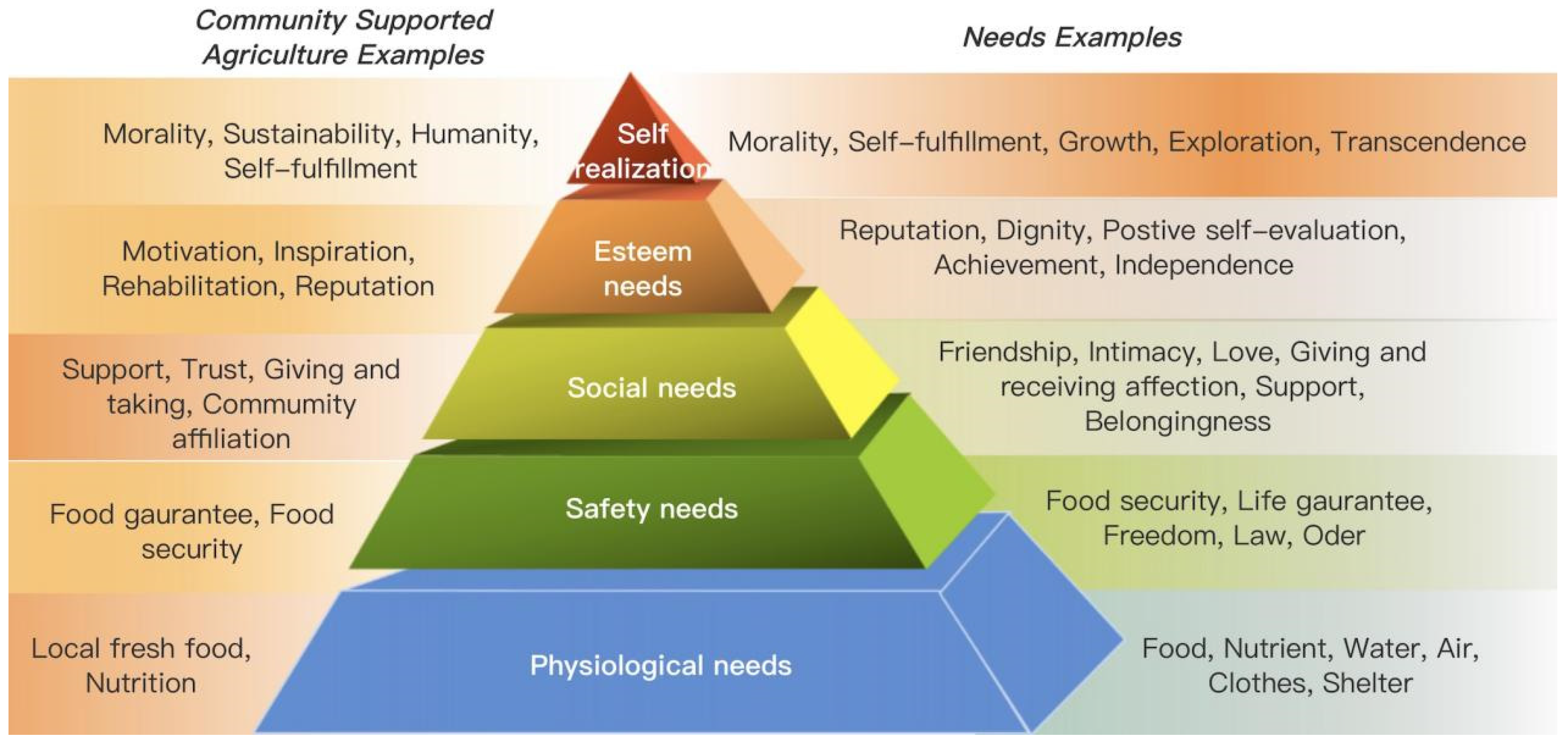

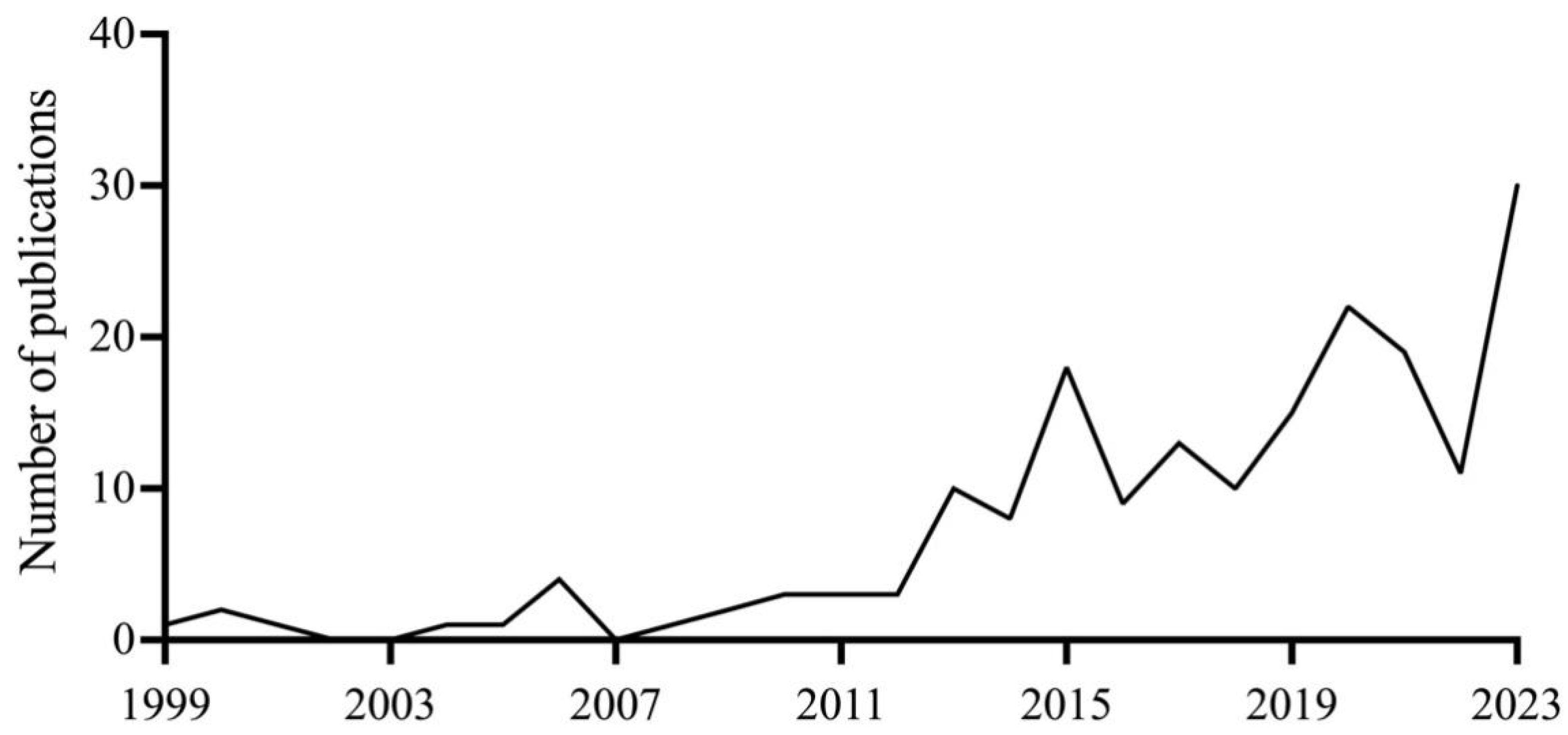

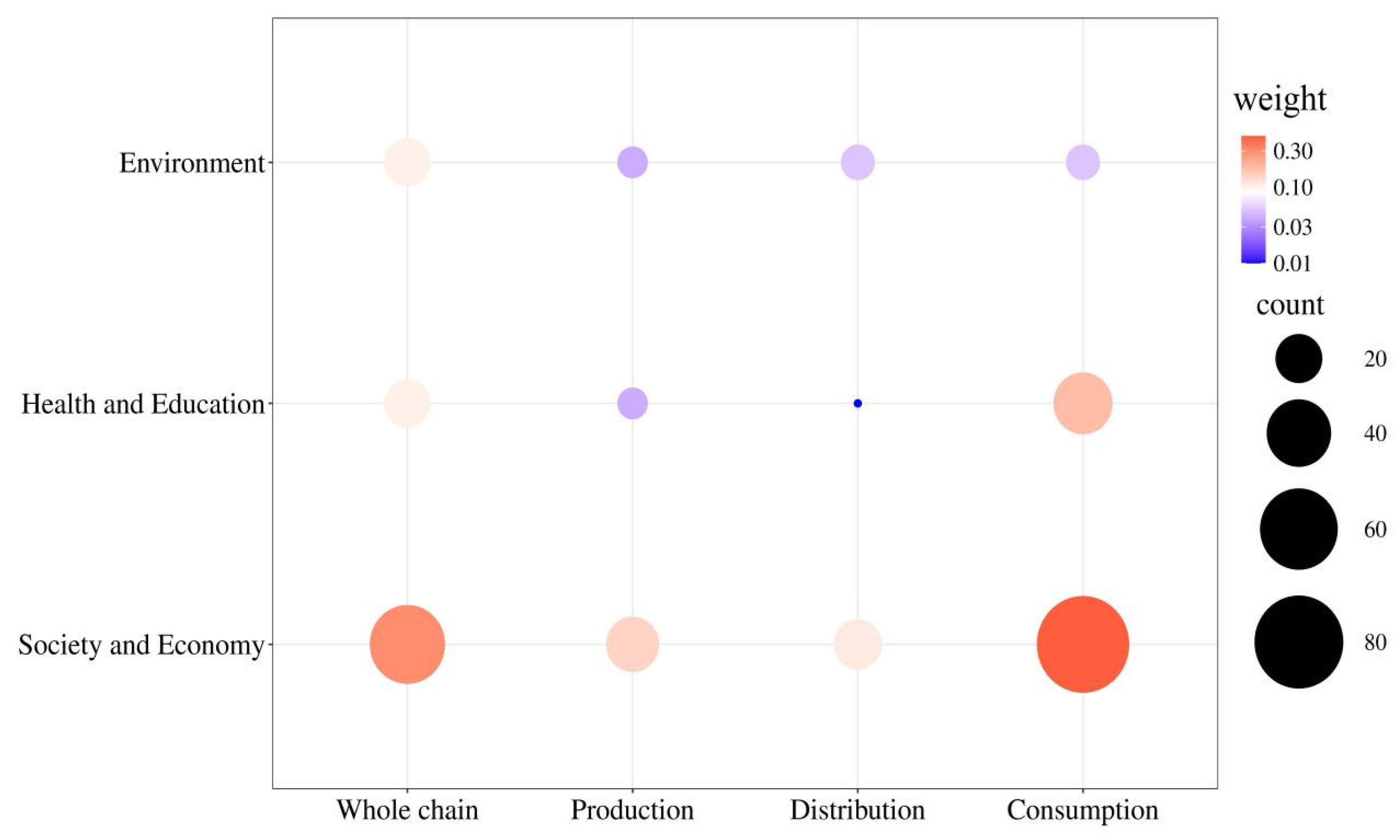
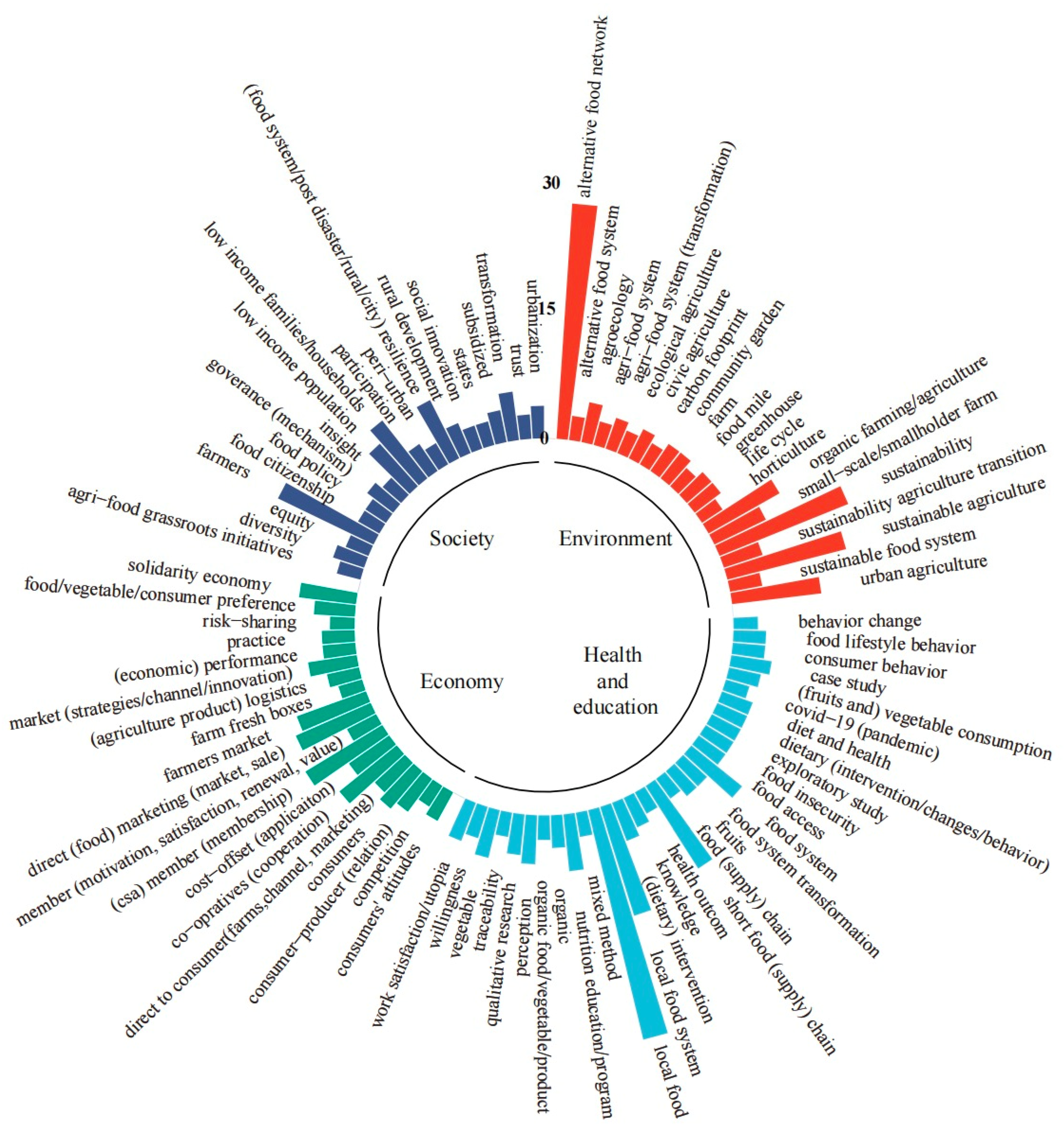
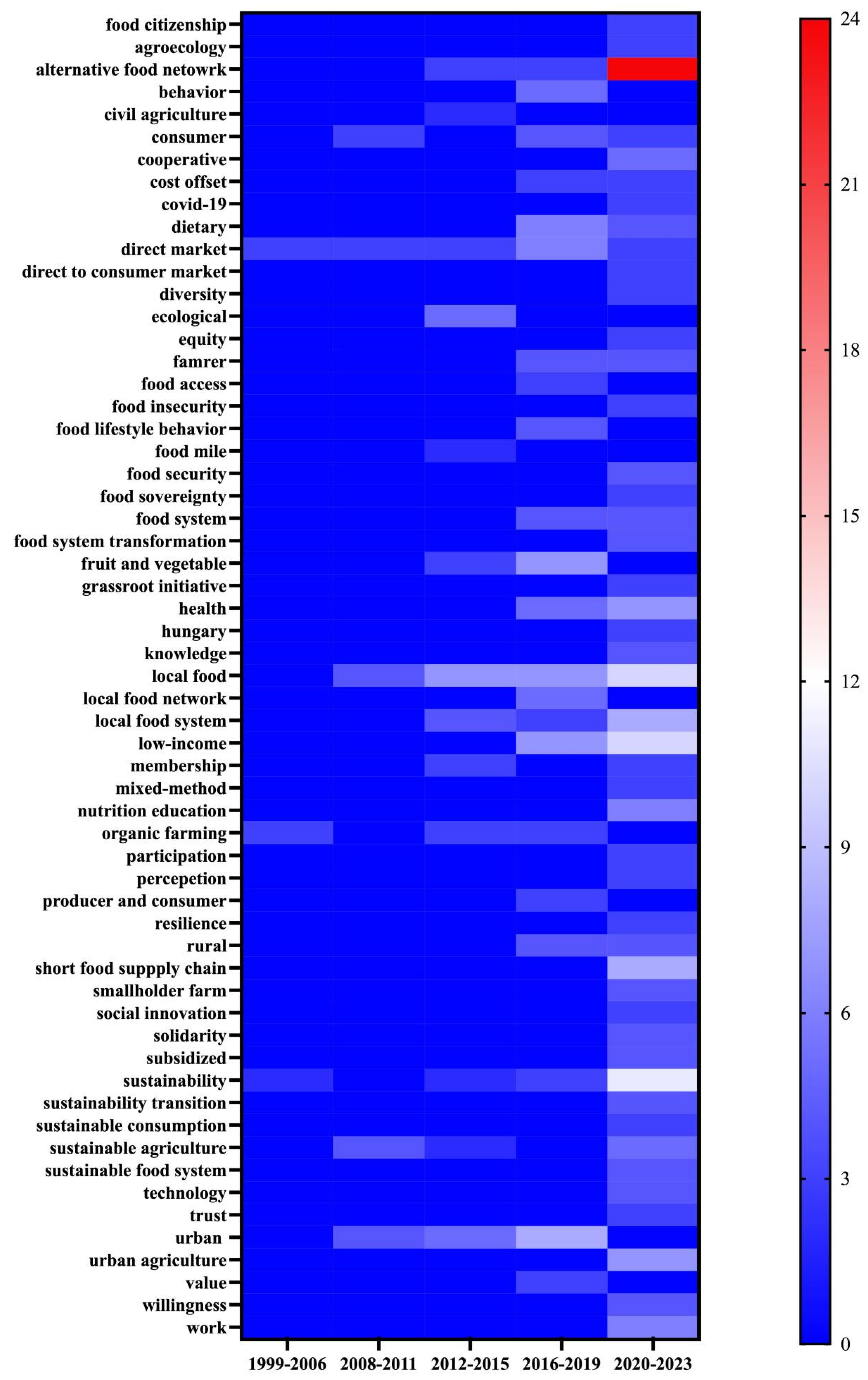
| Approaches | |
|---|---|
| Description | Examples |
| Same word root but in different forms | “alternative food network [4]” vs. “alternative food networks [31]” (network) |
| Excess ending word | “solidarity [32]” vs. “solidarity economy [16]” |
| Similar terms that may be merged | “organic farming [33]” and “organic farms [34]” are merged |
| Terms that have the same meaning | “low-income households [35]” vs. “poverty [36]” |
| Subset terms that may be merged | “short supply chain [37]” and “short food supply chain [30]” are merged |
Disclaimer/Publisher’s Note: The statements, opinions and data contained in all publications are solely those of the individual author(s) and contributor(s) and not of MDPI and/or the editor(s). MDPI and/or the editor(s) disclaim responsibility for any injury to people or property resulting from any ideas, methods, instructions or products referred to in the content. |
© 2024 by the authors. Licensee MDPI, Basel, Switzerland. This article is an open access article distributed under the terms and conditions of the Creative Commons Attribution (CC BY) license (https://creativecommons.org/licenses/by/4.0/).
Share and Cite
Tian, X.; Zhang, R.; Wang, Z.; Kang, X.; Yang, Z. Exploring Community-Supported Agriculture through Maslow’s Hierarchy: A Systematic Review of Research Themes and Trends. Agriculture 2024, 14, 1568. https://doi.org/10.3390/agriculture14091568
Tian X, Zhang R, Wang Z, Kang X, Yang Z. Exploring Community-Supported Agriculture through Maslow’s Hierarchy: A Systematic Review of Research Themes and Trends. Agriculture. 2024; 14(9):1568. https://doi.org/10.3390/agriculture14091568
Chicago/Turabian StyleTian, Xiaofan, Ruifang Zhang, Zifan Wang, Xinna Kang, and Zhixin Yang. 2024. "Exploring Community-Supported Agriculture through Maslow’s Hierarchy: A Systematic Review of Research Themes and Trends" Agriculture 14, no. 9: 1568. https://doi.org/10.3390/agriculture14091568
APA StyleTian, X., Zhang, R., Wang, Z., Kang, X., & Yang, Z. (2024). Exploring Community-Supported Agriculture through Maslow’s Hierarchy: A Systematic Review of Research Themes and Trends. Agriculture, 14(9), 1568. https://doi.org/10.3390/agriculture14091568





